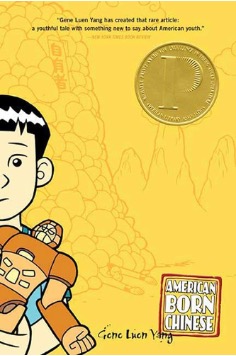
The Gospel in “American Born Chinese”: An Introduction to Contextualization
Today I’m happy to introduce you to my former student “Crystal,” a guest blogger, for a series on contextualizing the gospel. You can read her bio at the end.
A Disney+ subscriber and a theologian walk into a coffee shop.The theologian asks: what does a nerd, a monkey, and a mythical scroll have to do with the gospel?
The Disney+ subscriber answers: I watched that show.
What Does the Gospel Have to Do with American Born Chinese?
In May 2023, the American Born Chinese television series released on Disney+ to critical acclaim. In the series, Jin Wang, the son of Taiwanese immigrants, conceals his nerdy interests in an attempt to join the popular soccer clique. One day, Wei-Chen transfers to Jin’s school. Unlike Jin, Wei-Chen is loud, open, and clearly a FOB (“Fresh Off the Boat”). He also happens to be the son of Sun Wukong, more commonly known as the Monkey King, a prominent figure in Chinese literature. Wei-Chen had a prophetic dream about the mythical Fourth Scroll, and he believes Jin can help him find it.
The television series is based on the 2006 award-winning graphic novel of the same name. The author, Gene Luen Yang, drew inspiration from his own life as an ABC—and from his Christian faith.
In retelling the Monkey King’s story, Yang Christianizes Buddha, renaming him Tze-Yo-Tzuh, “He Who Is” (Rev 1:8; cf. Exod 3:14; ABC, p. 80). He reinvents the Monkey King’s famed Journey to the West as the three wise men’s pilgrimage to the newborn Jesus. And when Tze-Yo-Tzuh rebukes the wayward Monkey King, he paraphrases Psalm 139:
“I am Tze-Yo-Tzuh. I was, I am, and I shall forever be. I have searched your soul, little monkey. I know your most hidden thoughts. I know when you sit and when you stand, when you journey and when you rest. Even before a word is upon your tongue, I have known it. My eyes have seen all your days.
Where did you think you could hide from me? Where can you flee from my presence?”
But is it really okay to put the voice of God in Buddha’s mouth? Even a Buddha morphed into Christ?
In attempting to make the Christian God accessible to a wider audience, has Yang blended Chinese mythology and biblical truth to the point that the two have become indistinguishable?
Contextualization in American Worship
Look around the next time you attend a worship service. You’ll find many examples of contextualization.
For example, let’s look at the American church (because this writer attends one). The typical American church worships on Sunday, elevates the pastor physically above the congregation, offers a lecture-like sermon, and lasts about an hour. This differs from the way that Jesus, Paul, and the early church worshipped.[i] But no one would claim that the American church worships incorrectly. Instead, the church has contextualized worship to make the gospel accessible to a contemporary Western audience.
Likewise, many Christmas traditions draw from the pagan holiday of Yule. And no disciple was paid a visit by the Easter Bunny or went on an Easter Egg Hunt.
Does this mean we can’t exchange presents or tell stories about Santa during the Christmas season? Should we stop hiding colorful eggs around the house on Easter Day?
Contextualization of the Gospel
Here’s the good news for our human-made traditions: all worship is contextual.
This reality is biblical, for God intended the gospel to be contextual. Jesus contextualized it when he came down to earth in human flesh. But over time, the church has often assumed Western norms while condemning other forms of contextualization as syncretism, as bad worship.
Earlier, I described a typical Sunday Service in an American church. Now, what if I told you about a Christian who worships in a sweat lodge with a drum and who prays with sick family members in a ceremony that takes place in a hogan (a traditional Navajo hut made of logs and earth)? Would you worry that the Christian is clinging to pagan superstitions?[ii]
Syncretism vs. Counteractive Syncretism
Syncretism is the blending of different religious beliefs.[iii] Historically, the Western church has condemned all syncretism as heresy. But what exactly has the term been used to signify? And who decides what is false/syncretistic? [iv]
Perhaps we need to reconsider the meaning of syncretism, the scope of which extends beyond Western-centered definitions. Native theologian Richard Twiss defines syncretism as the exploration of the synthesis of faith, belief, and practice in a dynamic process that produces mature followers of Christ without taking away from the authority of Scripture or orthodoxy.[v]
There is legitimate concern over what Twiss identifies as counteractive syncretism: the “blending or mixing of different core religious beliefs, which ultimately diminishes, fully resists or finally stops—‘counteracts’—one’s personal faith journey as a follower of Jesus and his ways” (emphases mine).[vi]
In summary:
- Syncretism contextualizes the gospel in a way that honors both a person’s culture and their orthodox faith as a follower of Jesus and his ways.
- Counteractive syncretism directs a person’s primary allegiance to someone or something other than Christ, resulting in the rejection of core Christian beliefs.[vii]
Contextualization in American Born Chinese

American Born Chinese blends Chinese mythology with the biblical story. At first glance, Yang’s theology seems syncretistic in a way that points away from Christ because it seeks to understand the Christian faith through myth.
Yet, Yang’s work actually falls within a Western tradition of faith seeking understanding through the fantastic. C.S. Lewis told the gospel through the lens of Greek mythology in Till We Have Faces. J.R.R. Tolkien, George MacDonald, and G.K. Chesterton explored Christian themes through fantasy worlds of their own creation. These “fairy-stories,” as Tolkien called them, prepare believers for their hope in the greatest fairy-story, which took place in actual space and time: the gospel.[viii]
Yang differs only in that he draws upon Chinese mythology to portray Jin’s spiritual journey. He thus contextualizes the gospel for Asian Americans without delving into counteractive syncretism.
A Disney+ Subscriber and a Theologian Walk into a Coffee Shop
So, what does a nerd, a monkey, and a mythical scroll have to do with the gospel?
Jin Wang (the nerd) initially rejects the person that God created him to be. Instead, he seeks acceptance and belonging by conforming to soccer-clique norms. But when he meets Wei-Chen (the monkey) during the latter’s search for the (mythical) Fourth Scroll, Jin learns to reconcile with his Chinese heritage—and his nerdy love of anime and comics. He learns to love the person that he was created to be.[ix]
And the gospel points us to the place where we can find true acceptance and belonging: Jesus Christ.
—
This is the first in a three-part series on contextualization. Today, we examined the difference between contextualization/syncretism and counteractive syncretism through the lens of American Born Chinese. In my next column we’ll look at biblical precedence for contextualizing our faith. After that, we’ll look at ramifications and applications of contextualization for the church today.
[i] See Mark Charles and Soong-Chan Rah, Unsettling Truths: The Ongoing Dehumanizing Legacy of the Doctrine of Discovery, (Downers Grove, IL: InterVarsity Press, 2019), 86–87.
[ii] Example pulled from Charles and Rah, Unsettling Truths, 86–87.
[iii] Richard Twiss proposes that syncretism is a transitional process that is a normative part of believers’ spiritual growth. People move in and out of syncretism as they “embrace, reject, modify, learn and grow toward spiritual maturity following Jesus.” Syncretism is thus not the end of the process, though it may be where an individual lands in their faith journey. Twiss provides his personal example as a Christian who has a core allegiance to Jesus that is enriched and informed by traditional Lakota ceremonial ways and beliefs in a way that allows him to hold the exclusive claims of Christ without losing his faith (Rescuing the Gospel from the Cowboys: A Native American Expression of the Jesus Way, [Downers Grove, IL: IVP Books, 2015], 28–35).
[iv] Peter van der Veer suggests that syncretism is a “politics of difference and identity … At stake is the power to identify true religion and to authorize some practices as ‘truthful’ and others as ‘false’” (“Syncretism, Multiculturalism and the Discourse of Tolerance,” in Syncretism/Anti-Syncretism: The Politics of Religious Synthesis, ed. Charles Stewart and Rosiland Shaw [New York: Routledge, 1994], 196–197).
[v] Twiss, Rescuing the Gospel from the Cowboys, 30, 33.
[vi] Twiss, Rescuing the Gospel from the Cowboys, 243.
[vii] Twiss, Rescuing the Gospel from the Cowboys, 35–36.
[viii] J.R.R. Tolkien, “On Fairy-Stories,” in The Monsters and the Critics and Other Essays, ed. Christopher Tolkien, (London: HarperCollinsPublishers, 2006), 156.
[ix] The television series takes creative liberties with the source material. Although the plot changes (there is no mythical Fourth Scroll in the graphic novel), the heart of the story remains the same: learning to love the person that God created you to be, and finding acceptance and belonging in the divine will.

Crystal holds a Master of Theology degree from Dallas Theological Seminary. A freelance writer and editor, she has the pleasure of helping others tell their own stories. Her passion lies in uplifting vulnerable populations. In her leisure time, you can find her walking her rescue dog, drinking a cup of hot tea, or getting lost in a good book. You can also follow her on X and Instagram @writecrystalc and on her website writecrystal.wordpress.com.




